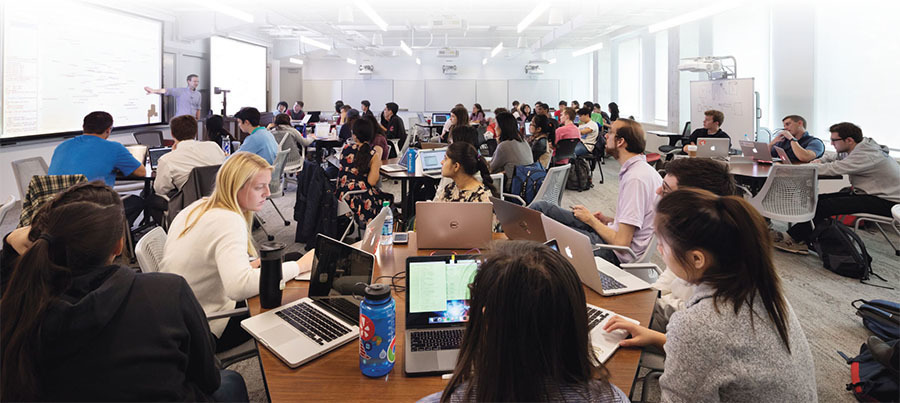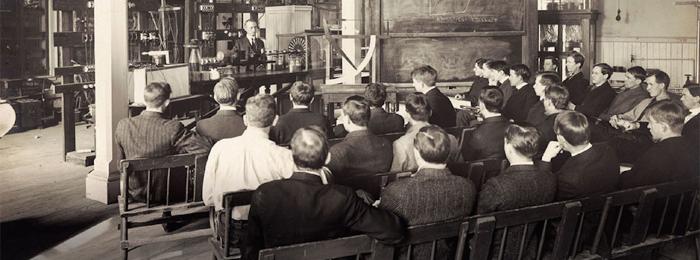SINK OR SWIM?
When you were an undergraduate student entering your first college classroom, chances are good you felt a little nervous. Believe it or not, if the professor teaching the class was new, they were probably just as nervous as you were. Until recently, it would have been a fair bet that a new faculty member had just about zero formal training in how to teach. For those new professors, it probably felt very much like a ‘sink or swim’ situation.
Some swam right away and took to classroom teaching like fish to water. Others probably struggled. And it’s no surprise. In addition to teaching, professors must work on their research, mentor students, serve on committees, apply for grants, write academic papers and accomplish many other tasks they often are not trained to do.
This is where Kathy Dimiduk ‘79 comes in. Dimiduk is director of the James McCormick Family Engineering Teaching Excellence Institute (MTEI) at Cornell Engineering. Dimiduk took the position in 2008 and has been focused on helping the faculty of Cornell Engineering become better teachers ever since.
Dimiduk understood that in order to know if teaching in the college is improving, she would need an instrument to measure teaching quality. She created a scale based on class evaluations, comprising six levels of teaching effectiveness. During her tenure as director of the MTEI, there has been a steady increase in the percentage of professors scoring at the top three effectiveness levels. In the most recent academic year fully 70% of engineering professors now reach this mark. The percentage of first-year faculty scoring in the top three levels has also increased dramatically.
Because of the consistently excellent research carried out at Cornell, it might be easy to forget that a major part of the university’s mission is to teach undergraduates. Dimiduk never forgets this charge. It is enshrined right there in the University Charter, which states: "The leading object of the corporation hereby created shall be to teach such branches of learning as are related to agriculture and the mechanical arts…" In other words, Cornell’s first responsibility is to teach.
MAKING A SPLASH
Dimiduk came to Cornell Engineering from her position as a senior lecturer in the Department of Physics and Astronomy at the University of New Mexico, where she taught physics and math. It was her experience reworking several classes that convinced Dimiduk she was ready to help others learn how to teach better.
"I’m a scientist," says Dimiduk. "I like research and I believe that we can look at teaching, collect data and use the data to help people become better teachers. When I saw this new position advertised at Cornell, I immediately saw it as an exciting opportunity to make an impact on the entire college." It is clear in conversations with Dimiduk that when she talks about having an impact on the college, what she means is helping students learn more. Dimiduk’s way of improving students’ classroom experience is by making their teachers better.

Dimiduk’s commitment to Cornell is not strictly professional. She grew up in Ithaca; her mother and father held faculty positions at Cornell and she herself earned an undergraduate degree in physics at Cornell. From Ithaca, Dimiduk went on to receive her Ph.D. in applied physics from Stanford University. She had 20 years of college teaching experience before coming back to Cornell to lead the Teaching Excellence Institute.
SWIMMING LESSONS
Dimiduk approaches her job pragmatically. "Nobody wants to be a bad teacher," she says. "And if I can recommend fairly simple changes that are based in data and don’t require a lot of work to implement, then teachers are more likely to give them a try." This approach is what Jim McCormick ‘69, M.Eng. ‘70, is referring to, in part, when he says that Dimiduk has "uncommon common sense."
"Kathy is spectacular," says McCormick, whose $5 million gift endowed the MTEI in 2013. "She is the essence of uncommon common sense. Many colleges will hold an optional ‘best practices’ seminar for their professors once a year and expect it to make a difference in how well people teach. Kathy knows that approach does not work."
When faculty members find themselves in this sink-or-swim classroom teaching situation, Dimiduk offers the equivalent of swimming lessons. "It’s a matter of finding out what people need," says Dimiduk, "of finding their pain points and then giving one or two specific recommendations that are easy to implement. Engineers are problem solvers and these professors are engineers with a problem to solve, so they are happy for the help."
Dimiduk helps faculty improve their teaching through individual consultations, classroom observations, new faculty workshops, mid-semester evaluations, help with the art and the science of student assessment, grant proposal support and a large stockpile of online tips and resources.
Hadas Ritz, senior lecturer in the Sibley School of Mechanical and Aerospace Engineering and a Faculty Teaching Fellow in the MTEI, works with Dimiduk to co-lead some of the new faculty workshops and to help spread the word about something called active learning.
The traditional model of teaching in higher education is sometimes called the "Sage on the Stage" model. In engineering classes, that means a professor stands in front of the class and lectures. Students listen, take notes, ask questions and then wrestle with the material outside of class doing problem sets for homework. "Some students will be able to learn the material this way," says Ritz. "But research has shown that most students will absorb the information better if it is presented in a variety of ways and students have a chance to practice skills and apply the knowledge right away, with feedback."
Active learning is an approach to teaching that emphasizes student involvement and engagement. Rather than treating learning as something that happens to a student, active learning practitioners understand that a student is at the center of education and that the more a student can talk, write, problem solve and reflect on the material, the more deeply they might understand it. Dimiduk says, "active learning supports deeper, more resilient learning that is retained longer and is more easily applied to new problems students will face across their careers."

Ritz, who has implemented many active learning strategies in her own teaching, says, "anything you can change so that it’s not just [students] writing down what you say, those changes will help them learn more. Students are coming to us with different expectations. A lot of these changes in teaching are already happening in high schools. Students show up today ready to engage with the material and if we aren’t changing how we teach we’re missing an opportunity to be better."
Kirstin Petersen, assistant professor of electrical and computer engineering, is not missing any of these opportunities. "I use a variety of approaches in my teaching," says Petersen, "including traditional lectures, flipped classrooms, in-class trivia and more."
A major change Petersen has made is getting rid of the idea of a textbook for her Intelligent Physical Systems class. "This class covers too many topics, and robotics develops too rapidly to rely on any one book," says Petersen. Rather than asking the students to buy a textbook, Petersen assigns her student to small teams and each team creates a publicly-accessible website. "Teams update their sites throughout the semester and then the sites stay up for future generations of students to refer back to and learn from." In effect, the students are creating living textbooks as the semester progresses.
Frank Wise, the Samuel B. Eckert Professor of Engineering in the School of Applied and Engineering Physics, is a veteran faculty member who has been teaching at Cornell since 1988. "I’ve always known that lectures are not the most effective way to teach," says Wise, "so I have been working with Kathy and other teaching experts on campus to ‘flip’ my classroom."
A flipped classroom is an instructional strategy where lecture content is delivered outside of class time—most often online. Students then come to class and work through problems alone or in small groups, applying the information they learned online or in assigned readings. This allows professors and teaching assistants to clarify points of confusion and to address misconceptions. It also allows students to ask questions as they work on problems—something traditional homework assignments don’t allow for.
"I am using the flipped classroom approach for the junior quantum mechanics class," says Wise. "The students view video lectures before class meetings. During class they work in groups of 2-4 on exercises designed to illustrate the concepts from the lecture. I can say that student engagement is close to 100% in every class now. And the course evaluations…were quite positive about the change. I cannot imagine going back to the traditional lecture format."
The bottom line for Ritz, Petersen and Wise is that if they can become better teachers, students will be the ones who benefit.
C’MON IN, THE WATER’S FINE
Some of the teaching innovations that characterize active learning require classrooms specifically designed to support this sort of break-the-rules instruction. Cornell Engineering has shown a real commitment to creating these kinds of classrooms. The furniture in some of these rooms can be quickly rearranged to facilitate one-on-one, small group, and whole-class activities and discussions. The technology in the rooms allows iClicker student response activities and checks of comprehension in real time. There are multiple screens throughout the room so that professors can incorporate video in effective ways.
When Upson Hall was hollowed out and remade a few years ago, eight of the classrooms were built specifically to be used by professors incorporating a variety of active learning strategies. And as the plans for a fully-renovated and reimagined Hollister Hall are developed they will include more classrooms specifically built for teachers to use active learning strategies and techniques.
Another innovation led by Dimiduk is the mid-semester course feedback tool. Students in engineering classes, such as MTEI Faculty Teaching Fellow Michael Clarkson’s computer science courses, are asked half way through the semester how things are going. Dimiduk gathers their responses and quickly crunches the results. She then gets back to professors with specific targeted feedback they can implement immediately. "Sometimes I think I am a translator for professors," says Dimiduk. "If I can put something so that they can see the use of it in their specific class, they might then take it and run with it. There is already evidence that these mid-semester nudges are making classes better."
Dimiduk also has data that show the new faculty workshops sponsored by MTEI are having an effect. Since these workshops have been offered regularly and department heads have been strongly recommending them for their new hires, these new faculty members are getting consistently higher ratings on teaching evaluations.
Having the data to show the value of what the MTEI offers is essential. Associate Dean for Undergraduate Studies Mike Thompson says, "Kathy has improved our end-of-semester course evaluations by altering the focus of the questions. Having good data to show improvement carries a lot of weight with engineers. And it helps build trust and confidence in what Kathy and the MTEI are doing."
McCormick agrees on the importance of data when it comes to improving teacher quality. "Cornell Engineering has put added emphasis on teaching quality as part of the tenure decision in the past few years. If the college is going to do that, it also needs to put resources into making sure professors have support to improve their teaching. It becomes essential to have good data to know those resources are being used well," says McCormick.
"Cornell Engineering is really challenging the higher-ed status quo of non-fact-based assumptions that ‘of course our professors are good teachers.’ The things Kathy does make professors better teachers and make Cornell a better university. And we have the data to back that up."


